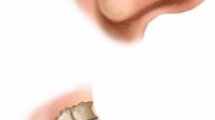Abstract
Background
Dorsal preservation techniques have been preferred and gained popularity in recent years. The current study compares the effects of dorsal preservation and dorsal reduction rhinoplasty on nasal patency and aesthetic outcomes by using Patient-Reported Outcome Measures (PROMs) and rhinomanometry. To our knowledge, this is the first study to compare dorsal preservation and dorsal reduction techniques with rhinomanometry.
Methods
This is a prospective study of 34 patients who underwent rhinoplasty between January 2021–June 2022. The patients were randomly selected preoperatively and divided into two groups as structural rhinoplasty (SR) and preservation rhinoplasty (PR). Nasal Obstruction and Symptom Evaluation (NOSE), Standardized Cosmesis and Health Nasal Outcomes Survey (SCHNOS) scales and rhinomanometric evaluation were performed preoperatively, at 3rd month and 12th month postoperatively.
Results
Nineteen patients (10 female, 9 male) were in SR group, 15 patients (7 female, 8 male) were in PR group. There was not significant difference in terms of age and gender between groups. In both groups, NOSE, SCHNOS-O and SCHNOS-C results were found to be significantly lower at postoperative 3rd and 12th month compared to preoperatively (p < 0.001 for the entire SR group, p = 0.001 for the entire PR group). There was no significant difference between groups in terms of PROMs. Mean total nasal volume (TNV) at 12th month were statistically higher than preoperative value in PR group (p = 0.031). Also there was no significant difference in SR group and between groups in terms of rhinomanometry results.
Conclusion
Dorsal preservation with pushdown technique provides good functional and aesthetic results comparable with structural rhinoplasty.
Level of Evidence III
This journal requires that authors assign a level of evidence to each article. For a full description of these Evidence-Based Medicine ratings, please refer to the Table of Contents or the online Instructions to Authors www.springer.com/00266. A well-designed prospective clinical trial.


Similar content being viewed by others
References
Goodale JL (1899) A new method for the operative correction of exaggerated roman nose. Boston Med Surg J 140:112
Lothrop O (1914) An operation for correcting the aquiline nasal deformity; the use of new instrument; report of a case. Boston Med Surg J 170:835–837
Cottle MH, Loring RM (1946) Corrective surgery of the external nasal pyramid and the nasal septum for restoration of normal physiology. Ill Med J 90:119–135
Cottle MH (1954) Nasal roof repair and hump removal. AMA Arch Otolaryngol 60(4):408–414
Saban Y, Daniel RK, Polselli R, Trapasso M, Palhazi P (2018) Dorsal preservation: the push down technique reassessed. Aesthet Surg J 38(2):117–131
Daniel RK (2018) The preservation rhinoplasty: a new rhinoplasty revolution. Aesthet Surg J 38(2):228–229
Moubayed SP, Ioannidis JPA, Saltychev M, Most SP (2018) The 10-item standardized cosmesis and health nasal outcomes survey (SCHNOS) for functional and cosmetic rhinoplasty. JAMA Facial Plast Surg. 20(1):37–42
Gode S, Ozturk A, Sahin M, Berber V, Apaydin F (2019) Turkish validation of the standardized cosmesis and health nasal outcomes survey. Facial Plast Surg 35(4):397–399
Stewart MG, Witsell DL, Smith TL, Weaver EM, Yueh B, Hannley MT (2004) Development and validation of the Nasal Obstruction Symptom Evaluation (NOSE) scale. Otolaryngol Head Neck Surg 130(2):157–163
Karahatay S, Taşlı H, Karakoç Ö, Aydın Ü, Türker T (2018) Reliability and validity of the Turkish nose obstruction symptom evaluation (NOSE) scale. Turkish J Med Sci. 48(2):212–216
Vogt K, Bachmann-Harildstad G, Lintermann A, Nechyporenko A, Peters F, Wernecke KD (2018) The new agreement of the international RIGA consensus conference on nasal airway function tests. Rhinology 56(2):133–143
Okland TS, Kandathil C, Sanan A, Rudy S, Most SP (2020) Analysis of nasal obstruction patterns following reductive rhinoplasty. Aesthetic Plast Surg 44(1):122–128
Zoumalan RA, Constantinides M (2012) Subjective and objective improvement in breathing after rhinoplasty. Arch Facial Plast Surg 14(6):423–428
Hassanpour SE, Heidari A, Moosavizadeh SM, Tarahomi MR, Goljanian A, Tavakoli S (2016) Comparison of aesthetic and functional outcomes of spreader graft and autospreader flap in rhinoplasty. World J Plast Surg 5(2):133–138
Saban Y (2021) Commentary on: expanding ındications for dorsal preservation rhinoplasty with cartilage conversion techniques. Aesthet Surg J 41(2):185–188
Abdelwahab MA, Neves CA, Patel PN, Most SP (2020) Impact of dorsal preservation rhinoplasty versus dorsal hump resection on the internal nasal valve: a quantitative radiological study. Aesthetic Plast Surg 44(3):879–887
Taş BM, Erden B (2021) Comparison of nasal functional outcomes of let down rhinoplasty and open technical rhinoplasty using spreader graft. Eur Arch Otorhinolaryngol 278(2):371–377
Clement PA, Gordts F (2005) Standardisation Committee on Objective Assessment of the Nasal Airway, IRS, and ERS Consensus report on acoustic rhinometry and rhinomanometry. Rhinology 43(3):169–179
Lam DJ, James KT, Weaver EM (2006) Comparison of anatomic, physiological, and subjective measures of the nasal airway. Am J Rhinol 20(5):463–470
Acknowledgement
The authors declare that they have no conflict of interest.
Funding
No funding was obtained for this study.
Author information
Authors and Affiliations
Corresponding author
Ethics declarations
Conflict of interest
The authors declare that they have no conflict of interest.
Ethical Approval
All procedures performed in studies involving human participants were in accordance with the ethical standards of the institutional and/or national research committee and with the 1964 Helsinki declaration and its later amendments or comparable ethical standards.
Informed Consent
Informed consent was obtained from all individual participants included in this study.
Additional information
Publisher's Note
Springer Nature remains neutral with regard to jurisdictional claims in published maps and institutional affiliations.
Rights and permissions
Springer Nature or its licensor (e.g. a society or other partner) holds exclusive rights to this article under a publishing agreement with the author(s) or other rightsholder(s); author self-archiving of the accepted manuscript version of this article is solely governed by the terms of such publishing agreement and applicable law.
About this article
Cite this article
Alan, M.A., Kahraman, M.E., Yüksel, F. et al. Comparison of Dorsal Preservation and Dorsal Reduction Rhinoplasty: Analysis of Nasal Patency and Aesthetic Outcomes by Rhinomanometry, NOSE and SCHNOS Scales. Aesth Plast Surg 47, 728–734 (2023). https://doi.org/10.1007/s00266-022-03151-8
Received:
Accepted:
Published:
Issue Date:
DOI: https://doi.org/10.1007/s00266-022-03151-8




